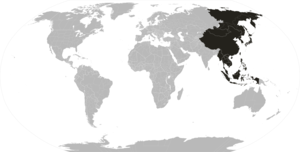| Far East | |||||||||||||||||||
|---|---|---|---|---|---|---|---|---|---|---|---|---|---|---|---|---|---|---|---|
 Location of the Far East, geographically defined | |||||||||||||||||||
| Chinese name | |||||||||||||||||||
| Traditional Chinese | 遠東 | ||||||||||||||||||
| Simplified Chinese | 远东 | ||||||||||||||||||
| Literal meaning | Far East | ||||||||||||||||||
| |||||||||||||||||||
| Burmese name | |||||||||||||||||||
| Burmese | အရှေ့ဖျား ဒေသ | ||||||||||||||||||
| IPA | [ʔəʃḛbjá dèθa̰] | ||||||||||||||||||
| Vietnamese name | |||||||||||||||||||
| Vietnamese alphabet | Viễn Đông | ||||||||||||||||||
| Chữ Hán | 遠東 | ||||||||||||||||||
| Thai name | |||||||||||||||||||
| Thai | ตะวันออกไกล | ||||||||||||||||||
| RTGS | Tawan-ok Klai | ||||||||||||||||||
| Korean name | |||||||||||||||||||
| Hangul | 극동 | ||||||||||||||||||
| Hanja | 極東 | ||||||||||||||||||
| |||||||||||||||||||
| Mongolian name | |||||||||||||||||||
| Mongolian Cyrillic | Алс Дорнод Als Dornod | ||||||||||||||||||
| Japanese name | |||||||||||||||||||
| Kanji | 極東 | ||||||||||||||||||
| Hiragana | きょくとう | ||||||||||||||||||
| Katakana | キョクトー | ||||||||||||||||||
| |||||||||||||||||||
| Malay name | |||||||||||||||||||
| Malay | تيمور جاءوه Timur Jauh | ||||||||||||||||||
| Indonesian name | |||||||||||||||||||
| Indonesian | Timur Jauh | ||||||||||||||||||
| Filipino name | |||||||||||||||||||
| Tagalog | ᜃᜐᜒᜎᜅᜈᜈ᜔ Kasilanganan ᜐᜒᜎᜅᜈᜈ᜔ Silanganan (poetic) ᜋᜎᜌᜓᜅ᜔ ᜐᜒᜎᜅᜈ᜔ Malayong Silangan (literal) | ||||||||||||||||||
| Tamil name | |||||||||||||||||||
| Tamil | தூர கிழக்கு Tūra Kiḻakku | ||||||||||||||||||
| Portuguese name | |||||||||||||||||||
| Portuguese | Extremo Oriente | ||||||||||||||||||
| Russian name | |||||||||||||||||||
| Russian | Дальний Восток IPA: [ˈdalʲnʲɪj vɐˈstok] | ||||||||||||||||||
| Romanization | Dál'niy Vostók | ||||||||||||||||||
| Lao name | |||||||||||||||||||
| Lao | ຕາເວັນອອກໄກ Taven-ok kai | ||||||||||||||||||
| Khmer name | |||||||||||||||||||
| Khmer | ចុងបូព៌ា Chong Bopea | ||||||||||||||||||
| Tetum name | |||||||||||||||||||
| Tetum | Dok Lorosa'e | ||||||||||||||||||
The Far East is the geographical region that encompasses the easternmost portion of the Asian continent, including East, North, and Southeast Asia.[1][2] South Asia is sometimes also included in the definition of the term.[3][4] In modern times, the term Far East has widely fallen out of use and been substituted by Asia–Pacific,[5] while the terms Middle East and Near East, although now pertaining to different territories, are still commonly used today.
The term first came into use in European geopolitical discourse in the 15th century, particularly the British, denoting the Far East as the "farthest" of the three "Easts", beyond the Near East and the Middle East.[6] Likewise, during the Qing dynasty of the 19th and early 20th centuries, the term "Tàixī (泰西)" – i.e., anything further west than the Arab world – was used to refer to the Western countries.
Since the mid-20th century, the term has mostly gone out of use for the region in international mass media outlets due to its perceived Eurocentric connotations.[7][8][9] North Asia is sometimes excluded due to cultural and ethnic differences.[10]
The term is still used in Russia to refer to its sparsely populated easternmost regions (being "far" in this case from the political, economic and cultural centres, Moscow and Saint Petersburg).
- ^ "Oxford Dictionaries – Dictionary, Thesaurus, & Grammar". askoxford.com. Archived from the original on 29 September 2007.
- ^ "What is the Far East?". WorldAtlas. 1 August 2017. Retrieved 9 June 2022.
- ^ "Far East, Middle East, Near East". 13 July 2011. Archived from the original on 15 July 2023. Retrieved 15 July 2023.
- ^ "Far East Definition". Law Insider. Archived from the original on 15 July 2023. Retrieved 15 July 2023.
- ^ Farrell, Brian P.; Long, S.R. Joey; Ulbrich, David, eds. (18 July 2022), "From Far East to Asia Pacific: Great Powers and Grand Strategy 1900–1954", From Far East to Asia Pacific, De Gruyter Oldenbourg, doi:10.1515/9783110718713, ISBN 978-3-11-071871-3, retrieved 10 August 2024
- ^ "Where is the Middle East? The Near East? The Far East?". Dictionary.com. 24 February 2012. Retrieved 19 October 2021.
- ^ Fields, Larry. "The Eurocentric Worldwiew: Misunderstanding East Asia" (PDF). asj.upd.edu.ph. p. 40. Archived (PDF) from the original on 22 October 2015. Retrieved 9 June 2022.
- ^ "A menagerie of monikers". The Economist. 7 January 2010. Retrieved 9 July 2011.
- ^ Reischauer, Edwin and John K Fairbank, East Asia: The Great Tradition, 1960.
- ^ "East and Southeast Asia". ANDE. Retrieved 19 October 2021.